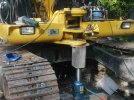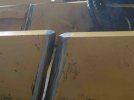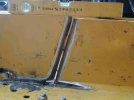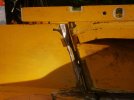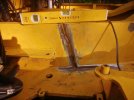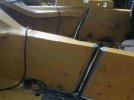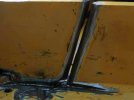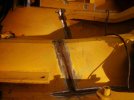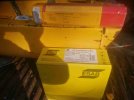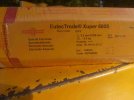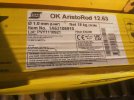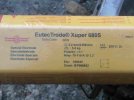The structure is cut out of board material, not fiber material. Special material, the material of the cut welding root sounds like the blade of a sword!The heat from welding the stiffener plates could have contributed to the cracking. It's not a big excavator so it's doubtful if any special welding procedures or higher nickel filler metals would have been used. Likely no preheat either which may have prevented the failure, especially if the weld on the stiffener started at the same place the crack started. Instant quenching effect. Even slight undercut from the weld on the stiffener could be where the crack started. It may even be case where the end of stiffener would have been better left un-welded. The same reason you don't typically weld across the boom on excavators. I don't know if the steel was cut from plate or was made as a long bar. Bar stock typically has the grain structure going lengthwise where plate has the grain structure going in multiple directions. Basically if pieces are cut from plate they will have equal strength no matter what position they are placed in. Pieces cut from flat bar only have max. strength in the direction of the grain structure. For a lot of stuff it won't matter but will on more critical weldments. Preheat before starting the repair.
-
Thank you for visiting HeavyEquipmentForums.com! Our objective is to provide industry professionals a place to gather to exchange questions, answers and ideas. We welcome you to register using the "Register" icon at the top of the page. We'd appreciate any help you can offer in spreading the word of our new site. The more members that join, the bigger resource for all to enjoy. Thank you!
You are using an out of date browser. It may not display this or other websites correctly.
You should upgrade or use an alternative browser.
You should upgrade or use an alternative browser.
Frame break Komatsu PC 110R
- Thread starter cat951b
- Start date
He got a little further in the repair over the weekend. I cut out and ground out the broken welds and tried to pull the frame of the machine back to its original position. Unfortunately, it won't be as simple as I thought. I lifted almost the entire machine with a 50 Ton Hydraulic Jack, but still there was a difference of 4 and 9 millimeters in the frame. Photos..
I lifted almost the entire machine with a 50 Ton Hydraulic Jack, but still there was a difference of 4 and 9 millimeters in the frame. Photos..
Attachments
I managed to get a special welding electrode for welding the frame, and a shielded gas welding wire with higher tensile strength for welding the belt plates.
Attachments
Welder Dave
Senior Member
I have no idea what you mean by board and fiber material??
The 680 S is a high strength stainless based rod. A little bit overkill since you aren't welding an exotic unknown steel but still a good choice albeit a very expensive option. The wire is standard ER70S-6 Mig wire, nothing special. Not sure what you mean by belt plates but if they help hold the frame together, I wouldn't use Mig. I'd only use Mig on non critical stuff or in spray mode in the flat position. Looks like you want about 300F preheat (since it's low to medium carbon steel) and then wrap the weld with welding blankets or insulation. You also don't want to get it super hot when welding. That probably won't be an issue though. They don't recommend post heating just slow cooling. It will be critical you have complete fusion with no flaws on the bottom of the frame welds. Any flaws there could cause it to crack again. The top is easy to see but the bottom you may need a mirror to look for flaws or confirm it's a good sound weld. If you see a flaw you may have to grind the weld out and redo it. When welding the bevels, do 1 or 2 passes on one side and then grind into that weld from the other side to insure 100% penetration.
As far as the gaps you want to get them about half the distance back together. They don't have to be pulled tight together. I'd guess 3 to 4mm gap would be good. The weld will shrink/contract upon cooling. You want the weld to have room to contract. Pulled tight and welded would create internal weld stress. When doing high pressure piping they normally add about 1/8"(3mm) to the pipe measurements and after welding it shrinks/contracts about half of the gap to the proper dimension. Larger pipes with bigger weld gaps will contract a little more. You may need to weld some brackets on the frame and use some big bolts to pull the sections together. Good luck with the repair. Take your time and don't try any short cuts. Just use sound welding techniques.
The 680 S is a high strength stainless based rod. A little bit overkill since you aren't welding an exotic unknown steel but still a good choice albeit a very expensive option. The wire is standard ER70S-6 Mig wire, nothing special. Not sure what you mean by belt plates but if they help hold the frame together, I wouldn't use Mig. I'd only use Mig on non critical stuff or in spray mode in the flat position. Looks like you want about 300F preheat (since it's low to medium carbon steel) and then wrap the weld with welding blankets or insulation. You also don't want to get it super hot when welding. That probably won't be an issue though. They don't recommend post heating just slow cooling. It will be critical you have complete fusion with no flaws on the bottom of the frame welds. Any flaws there could cause it to crack again. The top is easy to see but the bottom you may need a mirror to look for flaws or confirm it's a good sound weld. If you see a flaw you may have to grind the weld out and redo it. When welding the bevels, do 1 or 2 passes on one side and then grind into that weld from the other side to insure 100% penetration.
As far as the gaps you want to get them about half the distance back together. They don't have to be pulled tight together. I'd guess 3 to 4mm gap would be good. The weld will shrink/contract upon cooling. You want the weld to have room to contract. Pulled tight and welded would create internal weld stress. When doing high pressure piping they normally add about 1/8"(3mm) to the pipe measurements and after welding it shrinks/contracts about half of the gap to the proper dimension. Larger pipes with bigger weld gaps will contract a little more. You may need to weld some brackets on the frame and use some big bolts to pull the sections together. Good luck with the repair. Take your time and don't try any short cuts. Just use sound welding techniques.

